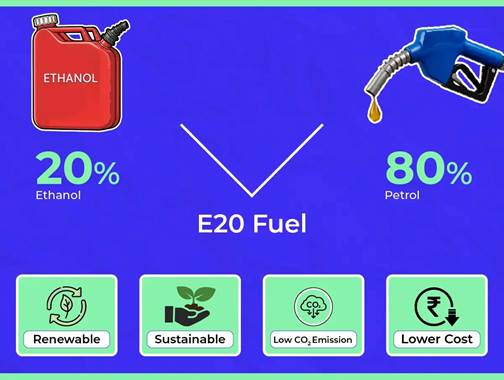Context and Policy Goals
- Govt. target: 20% ethanol blending (E20) by 2025.
- Objectives:
- Energy security → reduce crude oil imports (India imports ~85% of crude needs).
- Carbon emission reduction → lower GHGs.
- Rural income boost → new market for sugarcane, maize, rice, and agricultural residues.
- Waste utilisation → use of damaged food grains and crop residues.
Relevance : GS 3(Environment and Ecology , Science and Technology)

Scientific Basis of Ethanol
- Nature: Ethanol (C₂H₅OH) – an oxygenated biofuel.
- Production:
- From sugarcane/molasses via yeast fermentation.
- From food grains (maize, rice, broken grains).
- From lignocellulosic biomass (non-food crop residues – cellulose, hemicellulose, lignin).
- Process:
- Sugars → glucose (invertase) → ethanol + CO₂ (zymase).
- Key property: Hygroscopic (absorbs water), influencing corrosion and storage.
Energy Efficiency of Ethanol vs Petrol
- Calorific Value (CV):
- Petrol: ~43 MJ/kg.
- Ethanol: ~27 MJ/kg (≈35% lower).
- Implication → lower mileage per litre.
- Octane Number (ON):
- Petrol: 87–91.
- Ethanol: ~108.
- Higher ON → better resistance to knocking, smoother combustion.
- Net Result:
- Slight mileage drop at E20 (~2–4%).
- Noticeable only at E100 (100% ethanol).
Vehicle Impact – Scientific Concerns
- Hygroscopic Effect:
- Water absorption → rusting of tanks, clogging of fuel lines, reduced efficiency.
- Material Compatibility:
- Ethanol corrodes rubber and plastic components in older vehicles (fuel pipes, gaskets, injectors).
- Stoichiometric Ratio (Air–Fuel mix):
- Ethanol adds oxygen → alters combustion chemistry.
- Requires recalibration of spark timing and ECU (Electronic Control Unit).
- Engine Types:
- Modern BS-IV & BS-VI vehicles (post-2020): ECU-controlled → can adapt to E20.
- Older carbureted vehicles (pre-2020): No ECU → cannot be retrofitted easily.
Environmental & Emission Effects
- Positives:
- Reduced CO, NOx, and particulate emissions due to oxygen-enriched combustion.
- Lower lifecycle CO₂ if biomass sustainably sourced.
- Negatives:
- Land-use shift → possible diversion of food crops to fuel.
- High water footprint of sugarcane → aggravates groundwater depletion.
- Possible indirect emissions from fertilisers, transport, and processing.
Maintenance and Cost Concerns
- Govt. claim: Only one-time replacement of rubber components needed.
- Experts’ warning:
- Corrosion more severe in cold regions (moisture condenses).
- Regular servicing and higher maintenance costs inevitable for older vehicles.
- Recalibration of engines → increases manufacturing cost for auto industry.
International Experience
- Brazil:
- Started in 1970s (Proálcool programme).
- Currently runs on E27 + widespread use of flex-fuel vehicles.
- Transition was gradual, with subsidies, infrastructure, and farmer-industry linkages.
- USA:
- Large-scale corn ethanol production, but criticized for food vs fuel conflict.
- India’s challenge: Compressed timeline (2021 → 2025), unlike Brazil’s decades-long transition.
Science-Driven Challenges for India
- Agronomic:
- Heavy reliance on sugarcane → water-intensive (3,000–5,000 litres water per litre ethanol).
- Risk of food vs fuel diversion if maize/rice used extensively.
- Technological:
- Lack of widespread flex-fuel engine technology.
- Insufficient 2G ethanol production (from agri-waste).
- Infrastructure:
- Ethanol blending needs separate pipelines/storage tanks (due to hygroscopic nature).
- Higher transport costs for ethanol from rural production sites to refineries.
- Economic:
- High production cost of ethanol vs subsidised petrol.
- Fiscal burden of incentives/subsidies to sugar mills & distilleries.
Scientific Verdict
- Strengths:
- Cleaner combustion (less CO, PM).
- Energy diversification, import reduction.
- Adds rural economic value, waste-to-fuel potential.
- Weaknesses:
- Lower energy density → mileage drop.
- Corrosion/moisture issues in older vehicles.
- Water-intensive crops (sugarcane).
- Limited readiness of Indian vehicles for E20.
Way Forward
- Diversify feedstock: Promote 2G ethanol (crop residues, agri-waste, bamboo).
- Technology adoption: Encourage flex-fuel vehicles (as in Brazil).
- Agricultural reforms: Shift away from water-guzzling sugarcane → maize, sorghum, cellulosic biomass.
- Infrastructure: Invest in ethanol storage, blending, distribution systems.
- Policy pacing: Gradual transition (E10 → E12 → E15 → E20) with simultaneous vehicle adaptation.
- R&D push: Develop corrosion-resistant materials and better engine calibration technologies.



